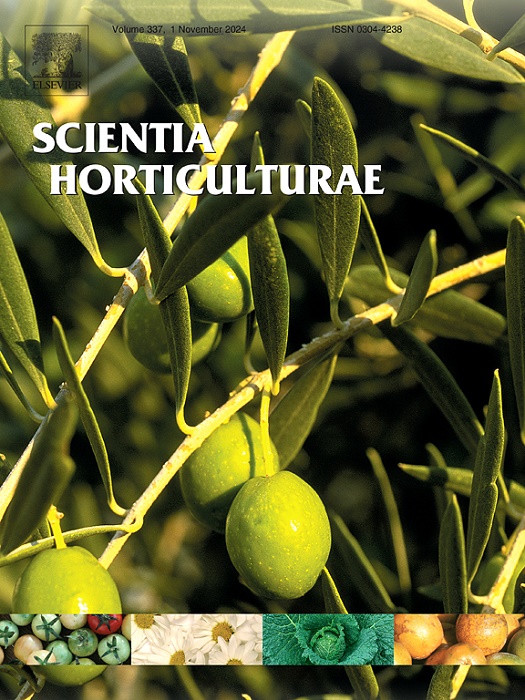采前施用茉莉酸甲酯调控果实成熟、颜色发育和改善植物化学品质的研究进展
IF 3.9
2区 农林科学
Q1 HORTICULTURE
引用次数: 0
摘要
茉莉酸(JA)及其甲酯茉莉酸甲酯(MeJA)越来越被认为是一种独特的植物激素,与多种生理和分子功能有关。茉莉酸盐(JAs)的内源浓度在植物部位、果实发育阶段、成熟期、成熟期和采后时期各不相同。MeJA表达主要的细胞反应,其中作为次级代谢物产生的激发子,有助于植物间通讯,调节相关植物激素的生物合成,支持植物防御系统抵御病原感染,并在非生物胁迫条件下提供帮助。MeJA在调节果实成熟、促进颜色发育和改善植物化学特征方面的潜力已被广泛研究,特别是在水果作物的抗氧化剂方面。采前施用MeJA调控果实成熟过程中的乙烯生物合成。收获前喷洒MeJA已被证明可以显著增加植物化学物质的生物合成,如酚类物质、类黄酮、花青素、类胡萝卜素、酶和非酶抗氧化剂以及必需营养素。收获前施用MeJA也上调了果实中香气挥发物的产生。据报道,采前喷洒MeJA可减轻冷藏水果的冷害。本文综述了JAs的生物合成及其对树木生长的影响;果实成熟生理学;色彩发展;色素生物合成的调控;果实硬度和生化特性的调节,包括抗氧化化合物,在成熟过程中,在收获和采后时期;从而弥合差距,获得更全面的理解。本文章由计算机程序翻译,如有差异,请以英文原文为准。

Preharvest methyl jasmonate application regulates ripening, colour development and improves phytochemical quality of fruits: A review
Jasmonic acid (JA) and its methyl ester, methyl jasmonate (MeJA), are increasingly being recognised as unique phytohormones, linked to a variety of physiological and molecular functions. Endogenous concentrations of jasmonates (JAs) vary among plant parts, stages of fruit development, maturity, ripening and during the postharvest period. MeJA expresses prime cellular responses, where as an elicitor of secondary metabolite production, aids in inter-plant communications, regulates the biosynthesis of associated phytohormones, supports plant defence systems against pathogenic infections, and helps in abiotic stress conditions. The potential of MeJA has been extensively studied in modulating fruit ripening, enhancing colour development, and improving the phytochemical profile, particularly for antioxidants in fruit crops. Preharvest application of MeJA regulates ethylene biosynthesis during fruit maturation and ripening. Preharvest MeJA sprays have been shown to significantly increase the biosynthesis of phytochemicals such as phenolics, flavonoids, anthocyanins, carotenoids, enzymatic and non-enzymatic antioxidants, as well as essential nutrients. Preharvest MeJA application also upregulates the production of aroma volatiles in fruits. Preharvest spray of MeJA is reported to alleviate chilling injury in cold-stored fruits. This review explores: the biosynthesis of JAs, their influence on tree growth; fruit ripening physiology; colour development; regulation of biosynthesis of pigments; fruit firmness and modulation of biochemical attributes, including antioxidant compounds, during the ripening process, at harvest, and during postharvest periods; therby bridging gaps towards a more comprehensive understanding.
求助全文
通过发布文献求助,成功后即可免费获取论文全文。
去求助
来源期刊

Scientia Horticulturae
农林科学-园艺
CiteScore
8.60
自引率
4.70%
发文量
796
审稿时长
47 days
期刊介绍:
Scientia Horticulturae is an international journal publishing research related to horticultural crops. Articles in the journal deal with open or protected production of vegetables, fruits, edible fungi and ornamentals under temperate, subtropical and tropical conditions. Papers in related areas (biochemistry, micropropagation, soil science, plant breeding, plant physiology, phytopathology, etc.) are considered, if they contain information of direct significance to horticulture. Papers on the technical aspects of horticulture (engineering, crop processing, storage, transport etc.) are accepted for publication only if they relate directly to the living product. In the case of plantation crops, those yielding a product that may be used fresh (e.g. tropical vegetables, citrus, bananas, and other fruits) will be considered, while those papers describing the processing of the product (e.g. rubber, tobacco, and quinine) will not. The scope of the journal includes all horticultural crops but does not include speciality crops such as, medicinal crops or forestry crops, such as bamboo. Basic molecular studies without any direct application in horticulture will not be considered for this journal.
 求助内容:
求助内容: 应助结果提醒方式:
应助结果提醒方式:


